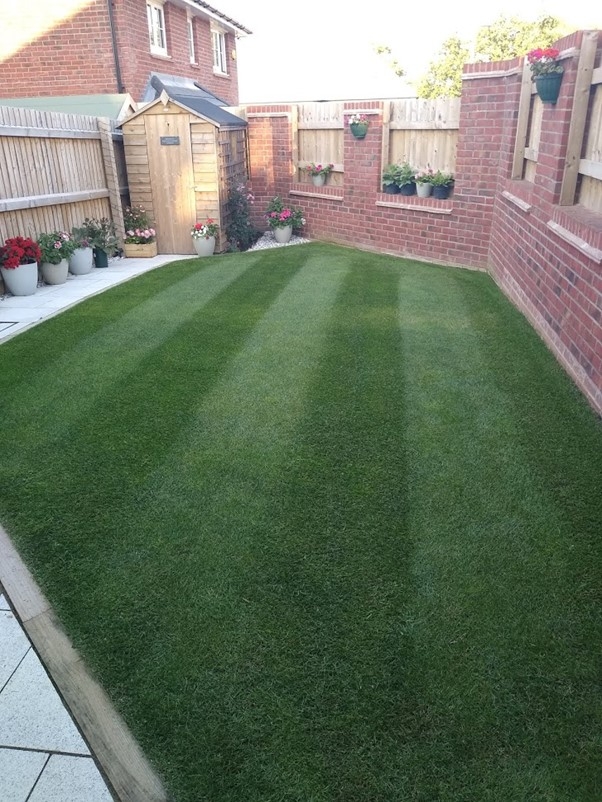New Build Garden Problems
Lawns which have been laid within new build estates in recent years have gained a bad reputation.
We keep an open mind when visiting all properties for the first time, but we quickly gain a good idea over the phone on what we are likely to find based on past experience.

New Build Lawns
Three words which fill the majority of lawn lovers and lawn care services with dread!
As discussed in other articles of mine, the vast majority of the soils we work with in our area are clay-based soils. Just because a soil is clay doesn't automatically make it a poor soil - Wimbledon and Lords being great examples!
So, what has gone wrong? Simply, not all clay soil has been treated the same. Soils which have been cultivated and managed over time are great for the lush green lawns we seek. This unfortunately hasn't been the case with new build lawns.
Clay soils possess very (very) small air pockets which during the building process have been crushed with heavy machinery and materials. They've been worked on in all conditions.
When these lawns are laid, they are often done so on a shoestring budget with little ground preparation - on ground that really needs this preparation and with little topsoil.
Is it the quality of turf?
We find that the relatively basic standard of turf used is more than adequate when looked after in most circumstances. Regardless of the turf, meadow grasses and weeds will look to grow in bear or thin areas where conditions suit. We do sometimes find that turf has been laid poorly with uneven lawns, or where gaps in the turf have opened up - but usually the problem is deeper.
If the lawn is ryegrass dominant then it can be susceptible to dying back in the winter months in areas where total shade is across a number of months. This is quite common when considering small new build gardens. Seeding these lawns with an appropriate shade tolerant mix is advisable in some cases.
Why is my new build lawn so wet?
Clay soils are normally poorly draining soils due to those very tightly packed clay particles and small air spaces - micro and macro pores.
When this soil has had the life crushed out of it this soil can perform worse still in terms of drainage.
It's important not to work on waterlogged lawns to prevent a greater compaction issue.
What can be done to improve a new build lawn?
1) Do the Basics
Firstly, be sure that the basics are being done. If the lawn is within 6 weeks old, be sure it is gaining enough water. Joins in the turf will be exposed regardless of how well turf has been laid if not watered adequately in dry weather. When the lawn is established and providing the lawn is dry enough to work on mow as frequently as required on a high setting to start.
Make sure you're mowing as late into the year as possible as it could be that from December to early March that the lawn is holding a fair amount of water and is unsuitable to be on.
Most new-build lawns being small in size do not see much sunlight during the shortest days and with the soil structure in mind, they get wet and stay wet.
2) Nutrition
New turf gains everything it could want when being grown in a field in terms of fertilisers. Your lawn will deteriorate with time if mowing is the only care it gets. Our Lawn Maintenance Programs can't change soil composition, but it will enhance colour, density and health of your lawn through the correct fertilisers, weed and moss control.
3) Aeration and Soil Improver
This can be difficult to execute but it's the best additional work in our experience without breaking the bank.
Deep aeration in October / November before lawns get too wet to work on, plus our Soil Improver Applications are the best products we can be applying on top of our Lawn Care Treatment Programme to be gaining the very best from poor soils.
It is worth noting that a fork isn't a lawn aeration tool. A fork pushes soil sideways and causes compaction at the base of the hole - it simply works to move soil around. Lifting back on the fork often causes root systems to break.
An aeration machine used in the correct conditions is the best way to go with garden forks reserved for beds and borders.
A machine provides an element of ‘heave’ – spiking and very slightly lifting at the ground as it travels across a lawn.
Learn more about our Lawn Aeration Service here.


4) Installing Drainage and / or Soil Exchange
Step four is for the lawn enthusiast only. To get the very most out of your patch this soil structure that we despise has to go. A soakaway is a common drainage solution, with the incorporation of better-quality soils – which are then better prepared before turfing or seeding.
Be aware of the volume of soil that true Soil Exchange is before undertaking this yourself. A cubic metre of soil is 10cm of soil over a 10m2 area. This is quickly a multi-tonne job on even the smallest of lawns before any grass is grown - I speak from experience!
We are not professional landscapers but we can certainly help with gaining the best from your garden through our Lawn Care Treatment, Programme and associated beneficial treatments like repairing bare patches in your lawn.
You can call us on 01827 826123 or complete our contact form if you would like us to help. We can advise on what would be the best course of action for your aims and budget.

